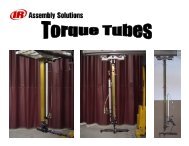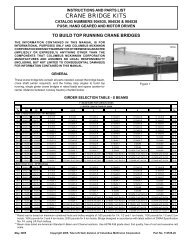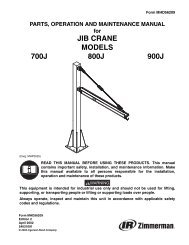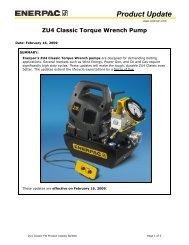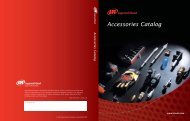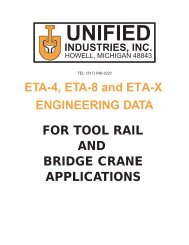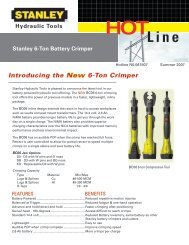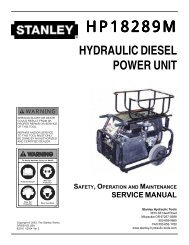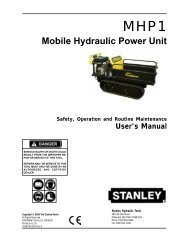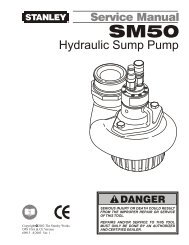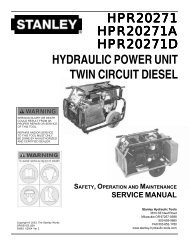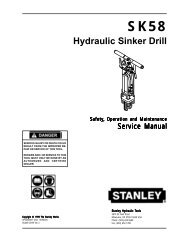You also want an ePaper? Increase the reach of your titles
YUMPU automatically turns print PDFs into web optimized ePapers that Google loves.
PREOPERATION<br />
PROCEDURES<br />
CHECK <strong>HYDRAULIC</strong> POWER<br />
SOURCE<br />
1. Using a calibrated flowmeter and pressure<br />
gauge, check that the hydraulic power source<br />
develops a flow of 9-10.5 gpm/34-40 lpm at 2000<br />
psi/140 bar.<br />
2. Make certain the hydraulic power source is<br />
equipped with a relief valve set to open at 2200-<br />
2300 psi/152-159 bar minimum.<br />
3. Check that the hydraulic circuit matches the tool<br />
for open-center (OC) or closed-center (CC) operation.<br />
CHECK TOOL<br />
1. Make sure all tool accessories are correctly<br />
installed. Failure to install tool accessories properly<br />
can result in damage to the tool or personal injury.<br />
2. There should be no signs of leaks.<br />
3. The tool should be clean, with all fittings and<br />
fasteners tight.<br />
CHECK TRIGGER MECHANISM<br />
1. Check that the trigger operates smoothly and is<br />
free to travel between the "ON" and "OFF" positions.<br />
CHECK GUARD ASSEMBLY<br />
1. Inspect the wheel guard assembly for cracks<br />
and other structural damage.<br />
10<br />
PREPARATION FOR INITIAL USE<br />
Each unit as shipped has no special unpacking or<br />
assembly requirements prior to usage. Inspection<br />
to assure the unit was not damaged in shipping<br />
and does not contain packing debris is all that is<br />
required. After installation of a cutting wheel a unit<br />
may be put to use.<br />
OPERATION<br />
INSTALLING AND REMOVING<br />
ABRASIVE CUTTING WHEELS<br />
NOTE: Use 14 in. / 350 mm diameter (for 14 in.<br />
model) or 16 in. / 400 mm diameter (for 16 in.<br />
model) abrasive cutting wheels with a 1 in.<br />
arbor hole. Only use cutting wheels which<br />
comply with ANSI B7.5/ISO 525, 603. Make sure<br />
the paper labels or blotters are installed between<br />
the wheel and collars.<br />
1. Before installing abrasive wheels, "sound" the<br />
wheel for possible damage by hanging the wheel<br />
vertically be the arbor hole and rapping lightly with a<br />
screwdriver handle or similar instrument. Thin,<br />
organic bond wheels will produce a low drumming<br />
tone if it is physically sound. If the wheel produces a<br />
"dead" or "flat" sound, it may be cracked. Cracked<br />
or damaged wheels must never be used.<br />
2. Check that the surfaces of the wheel that come<br />
in contact with blotters and flanges are free of dirt<br />
and other foreign particles.<br />
3. Remove the jam nut (77) and outside collar (78)<br />
by using a box type wrench while gripping the<br />
cutting wheel.<br />
3. Install the cutting wheel. Make sure blotters or<br />
labels remain on the cutting wheel.<br />
5. Reinstall the outside collar and jam nut. Tighten<br />
the jam nut with a box type wrench while gripping<br />
the cutting wheel. Only tighten sufficiently to<br />
prevent slippage of the wheel between the collars<br />
(78 & 79).<br />
DRIVESHAFT SPEED CHECK<br />
The speed of the motor output shaft should be<br />
checked at least every 100 hours of operation by<br />
trained and experienced personnel. A record of the<br />
speed checks should be maintained. The rated<br />
speed of the RS25 Rail Saw is 3600 rpm at 10 gpm<br />
/ 38 lpm for the 16 inch/400 mm model and 4500<br />
rpm at 10 gpm / 38 lpm for the 14 inch/350 mm<br />
model. The cutting wheel must be rated for a<br />
minimum of 4700 rpm for the 16 inch/400 mm<br />
model and 5300 rpm for the 14 inch/350 mm<br />
model. Tests should be conducted while operating<br />
the normal power supply used with the saw.



